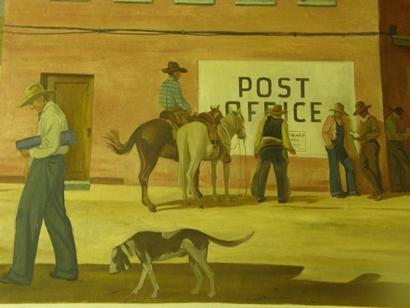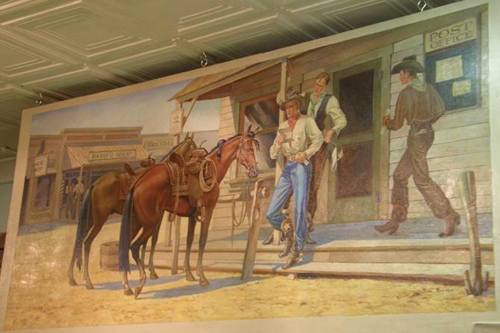| |
One
of my earliest memories is tagging along with my granddad back in the early 1950s
when he went to the Capitol every Sunday to check his mail.
Yes, the big
red granite building in downtown Austin
used to have a post office known as the Capitol Station. All the state agencies
got their mail there, but rental boxes also were available to the general public.
And yes again, the government actually used to put mail in boxes on Sunday, though
only once. On Saturday, as on every other day of the week, mail got placed in
boxes or delivered twice a day.
When I was about four, I got lost on one
of those Sunday visits when Granddad and I were probably the only two people in
the whole building. I wandered around the wide, silent halls crying until he finally
found me, that day’s mail clutched tightly in his hand.
With email and
other forms of digital communication virtually (pun intended) having killed old-fashioned
first class mail, it’s time to pay more attention to the history of all the hundreds
if not thousands of post
offices Texas has had over the years. Many have been closed and it doesn’t
take much imagination to realize that as postal revenue continues to decline,
more shuttered post offices will follow. |
 |
Ranger,
Texas Post
Office Mural "The Crossroads Town"
TE photo, September 2009 |
Each
of Texas’ 254 counties has its own postal history, but commonalities exist. The
prime postal history story in any county has to do with how a particular post
office got its name. Often, a spelling error or a mistake by the ubiquitous Washington
bureaucrat will be the story behind an unusual name. The other standard tale is
how a community went through several prospective post office names before the
folks in D.C. finally gave their approval.
The best example of that is
Mobeetie. Back in the 1870s, folks
in future Wheeler County wanted to call their town Sweetwater, but there was already
a Sweetwater in Nolan
County. So someone asked a friendly Indian how to say Sweetwater in whatever language
he spoke. His reply was “mobeetie.” Later, the possibly made-up story goes, a
cowboy was walking across the street when another Indian cautioned him not to
step in a steaming pile of mobeetie. |
 |
Another
aspect of Texas postal history that transcends county lines is that post offices
were more than a distribution point for written communication and published material
such as newspapers and magazines. They amounted to the social center of a community.
Often,
the post office was in the town’s general store, a place to buy groceries, clothes,
barbed wire, horse tack, and candy from the barrel – anything people needed, all
in one place. |
1907
Yoakum County Postal Map
Courtesy Texas General Land Office |
| On
the left border of the state, just across from New Mexico, is Yoakum County. Not
organized until 1907, it still has only 7,000 or so residents.
Sligo
Settled
in 1903, Sligo had the county’s
first post office. Pat McHugh, the first resident, named the new community for
Sligo County, Ireland. He and his family lived in a half dug out, but four years
later he built a small house which became a way station for travelers as well
as the post office.
Bronco
Yoakum
County’s second post office was in Bronco,
a town founded and named by H. “Gravy” Field. As postmaster, Field used the bed
of a covered wagon, with wheels removed, as a post office.
Field also
operated a store. Since he was most often out riding the range looking after his
cattle, he’s store was not only self-serve, it was based on the honor system.
Cowboys came in, collected the supplies they needed, left a list of what they
had bought and settled up later.
Most of Bronco’s
residents lived in dug outs, but Field had a wooden two-room house. When a neighbor
woman died, because of the scarcity of wood in the county, they removed a partition
from their house to build her a coffin.
Plains
W.J.
Luna filed on four sections in the middle of Yoakum County. In the spring of 1906
he set up a post office in his home. They named the post office Plains,
after the wide open space that constituted Yoakum County.
Originally from
Canyon, Luna
had lumber shipped from there to build a general store. When the store opened,
he moved the post office there.
While Sligo
and Bronco have
long since disappeared, Plains
remains the county seat and one of only two towns in the county, the other being
Denver City. (Don’t go there looking for any snow-covered peaks.)
Of course,
it does snow in Yoakum County. When a particularly heavy snow hit during the winter
of 1917-18, the women who then served as postmaster, Mrs. Thomas W. Hague did
extra duty by officiating at a funeral because no preacher was available.
P.S. A genealogical researcher in Austin County is looking for information
about two places she believes were post offices in that county back in the 1870s
– Pittsville and Iron Creek. Both were near the historic town of San
Felipe, which during the days of the Republic of Texas was a postal distribution
center because it sat on two major postal routes, Austin
to Houston and San
Felipe to Velasco on
the coast. If you know anything about those places, email me and I’ll pass it
along.
© Mike Cox
"Texas
Tales" February
25, 2010 column
|
|
Books by Mike Cox - Order Now |
| |